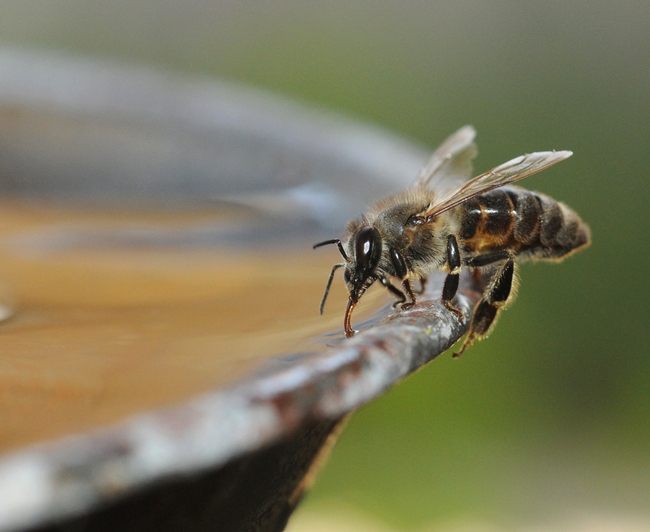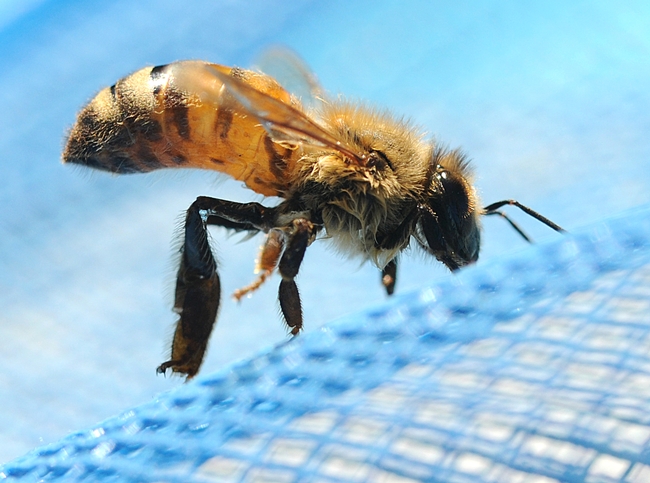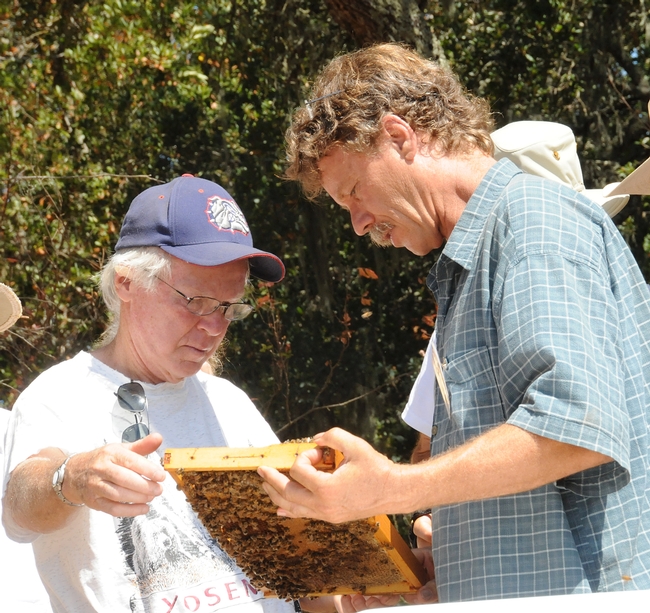- Author: Kathy Keatley Garvey

That's the question PBS Newshour asked Extension apiculturist (retired) Eric Mussen of the UC Davis Department of Entomology and Nematology for its "Just Ask" feature.
Mussen, who retired in June after 38 years of service but continues to maintain an office in Briggs Hall on the UC Davis campus, has been stung plenty of times. And the whole world knew it when this photo of "The Sting" (below) went viral.
When a bee stings, it cannot remove its barbed stinger without yanking out its abdominal tissue, aka "guts." It's basically a suicide mission in defense of its hive. Of the three castes in the colony, only the female worker bee dies when it stings. The queen can sting multiple times. The drone (male) has no stinger.
The stinger is hollow and pointed, like a hypodermic needle, Mussen told PBS Newshour reporter Anna Christiansen. The stinger, he explained, contains two rows of lancets, or saw-toothed blades.
Christianson also quoted Mark Winston, biologist and author of Bee Time: Lessons from the Hive (Harvard University Press) as saying that the blades alternate, “scissoring together into your flesh."
"It looks — and works — like a screw anchor, meaning that once in, the stinger can't retract," Christianson wrote. "Muscles connect the stinger to a venom sac, from which a cell-destroying toxin is pumped into the hole."
Mussen further explains bee stings in a UC Statewide Integrated Pest Management (UC IPM) Pest Note, Bee and Wasp Stings.
"Stingers are effective weapons because they deliver a venom that causes pain when injected into the skin," Mussen wrote. "The major chemical responsible for this is melittin; it stimulates the nerve endings of pain receptors in the skin. The result is a very uncomfortable sensation, which begins as a sharp pain that lasts a few minutes and then becomes a dull ache. Even up to a few days later, the tissue may still be sensitive to the touch."
"The body responds to stings by liberating fluid from the blood to flush venom components from the area. This causes redness and swelling at the sting site. If this isn't the first time the person has been stung by that species of insect, it is likely that the immune system will recognize the venom and enhance the disposal procedure. This can lead to very large swelling around the sting site or in a whole portion of the body. The area is quite likely to itch. Oral and topical antihistamines should help prevent or reduce the itching and swelling. Try not to rub or scratch the sting site, because microbes from the surface of the skin could be introduced into the wound, resulting in an infection."
Mussen says that nearly everyone has been stung by an insect at one time or another., and for beekeepers, it comes with the occupation. "It's an unpleasant experience that people hope not to repeat, but for most people the damage inflicted is only temporary pain," Mussen wrote. "Only a very limited portion of the population—one to two people out of 1,000—is allergic or hypersensitive to bee or wasp stings. Although this publication is about stings from bees and wasps, the information pertains to stings from fire ants as well."
He warns that it is important to remove the stinger immediately because the venom will continue to pump for 45 to 60 seconds following a sting. Mussen usually scrapes and removes the stinger with a fingernail. "Much has been written about the proper way to remove a bee stinger, but new information indicates it doesn't matter how you get it out as long as it is removed as soon as possible. Fingernails or the edge of a credit card are both effective tools. If a stinger is removed within 15 seconds of the sting, the severity of the sting is reduced."
Read more about bee stings in the PBS Newshour feature question, and in the UC IPM Pest Note, Bee and Wasp Stings.


- Author: Kathy Keatley Garvey
The declining bee population: Does chlorine in a swimming pool have anything to do with it?
Chlorine?
Ever since PBS NewsHour correspondent Spencer Michels interviewed Extension apiculturist Eric Mussen of the UC Davis Department of Entomology and several other UC scientists and bee folks on the declining honey bee population, it's been busy on the bee front.
Everyone seems to have a theory on the cause of colony collapse disorder (CCD) and why the bee population is declining.
One person, known as "DK," posted a comment on the PBS NewsHour site that maybe chlorine has something to do with it.
"Every morning, when I sweep (skim) the family pool here in Sherman Oaks (Los Angeles), Calif., at least 3-4 bees from a hive in a nearby hedge are dead in the water, and I don't think it's from drowning," DK wrote. "It's like the La Brea Tar Pits were eons ago: The sparkling pool looks like potable water, but it just lures them to their deaths...When I "googled" this subject, it turned out a farmer in the San Joaquin valley who was experiencing colony collapse discovered that a neighboring farmer was using a chlorine based pesticide in his irrigation water on the adjacent watermelon patch; when I read further into it, the article said chlorine was a suspected 'neuro-toxin" for the bees, and that corresponds with my empirical observations. The chemical component also might explain why only 25% of bee colonies are experiencing this problem."
"So, scientists in northern California and elsewhere, that's your clue: CHLORINE (and its derivatives). It's worth a look."
Mussen, a noted expert on honey bees, responded:
"I read with interest your concern about a possible connection between chlorine and our honey bee problems. I believe that you are correct that honey bees actually prefer a bit salty water to pure water, so they might be attracted to your swimming pool water. However, honey bees do not like to get their feet wet when collecting water, if they can help it. They stand on the dry and drink from the film of water caused by capillarity. If you find one drinking water near your pool, on the poll apron, pool wall or a floating toy, check their behavior.
"The bees you find in the pool probably were not there for drinking purposes. You noted that you have a colony living nearby. Each day that colony raises about 1,000 newly emerging adult workers and around six weeks later those 1,000 bees will die of old age. They do not die in the hive. They tend to keep foraging until they flutter to the ground (lawn, driveway, sidewalk, pool, etc.) wherever they may be. Those bees are not yet dead, so for a little while they still can sting if bumped against or stepped on. That is most likely why they keep ending up in your pool.
"In reference to your statement about chlorine in pesticides harming a beekeeper's bees, there have been a succession of pesticides with chlorine incorporated into their structures that are toxic to bees. The group named organochlorides are pretty much obsolete, but a new group of chemicals, called neonicotinoids, have a chlorine in them. Beekeepers fear those compounds because they become systemic in the plants and are found in the nectar and pollen when the plants bloom. Recently, the systemics have been delivered in irrigation water, since they can be picked up from the soil by the plant roots. In 'chemigation' with underground emitters, you would think that the chemicals would stay away from the bees. But, the systems leak and the bees will forage at the junctions in the pipes and from puddles on the ground. So, the bees get the chemical at field delivery concentrations, not at the much reduced concentrations that end up in the blossoms."
Speaking of water, as any beekeeper will tell you, bees don't like to get their feet wet. Honey bees don't dive into a pool on a hot summer day. They don't head for the sprinklers for a quick shower. They don't stand in water. When they collect water to cool their hives, they stand on the very edge of a water-filled container, such as a birdbath or the lip of a flower pot.
Which reminds us: a recently published children's book (for ages 4 to 10) about honey bees seemed to have it all: colorful illustrations, catchy lines, and educational information about bees.
One look at an illustration, though, and it's apparent that neither the author nor the illustrator know that much about water and honey bees. The illustration clearly shows honey bees walking in water. Three of them. Three of them happily walking in a water-filled birdbath.
"What's wrong with this illustration?" I quizzed a veteran beekeeper. He looked at me as if I'd just asked him the second letter of the alphabet.
"Bees," he said, "don't like to get their feet wet. Those bees in that illustration are walking in water. They don't do that."
No, they don't.


- Author: Kathy Keatley Garvey
Honey bees are still in trouble.
University of California scientists hammered home that point tonight during the PBS NewsHour program on the colony collapse disorder (CCD) and the declining bee population.
Extension apiculturist Eric Mussen of the UC Davis Department of Entomology told Spencer Michels of the PBS NewsHOur that "We really don't seem to have accomplished a whole lot (since CCD surfaced five years ago), because we're still losing, on an average, approximately 30 percent or more of our colonies each year. And that's higher than -- than it used to be. Only 25 percent of the beekeepers seem to have this CCD problem over and over and over. The other 75 percent have their fingers crossed and say, 'I don't know what this is, but it's not happening to me.'"
CCD is indeed frustrating, agreed Mussen, beekeeper-researcher Randy Oliver of Grass Valley, and UC San Francisco researchers Joseph DeRisi, Michelle Flenniken and Charles Runkel.
Flenniken, a postdoctoral fellow in the Raul Andino lab at UCSF and the recipient of the Häagen-Dazs Postdoctoral Fellowship in Honey Bee Biology at UC Davis, was among the team of scientists who recently discovered four new bee viruses, a discovery that may help unlock the secrets of why the bee population is declining.
The team found the new viruses while examining viruses and microbes in healthy commercially managed honey bee colonies over a 10-month period.
"Honey bee colonies, kind of like human populations, are exposed to a number of viruses and pathogens throughout the whole -- the entire course of the year," Flenniken told Michels. "So what this study provides us is a normal, healthy colony baseline of the ebb and flow of the microbes associated with that colony throughout the course of the year."
Oliver, who maintains 1000 hives and who has dealt with CCD, pointed out that CCD is resulting in "new science, new interest and new researchers" studying the mysterious malady.
As scientists delve in the mysteries of what's ailing the bees, they're bound to learn what's causing it. Meanwhile, it's good to see a national news program exploring this topic.
(Read PBS NewsHour transcript. Read more about the declining bee population on Spencer Michels' blog.)



